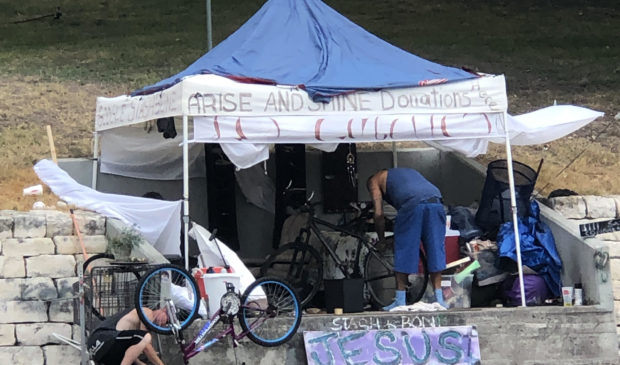Staff seeks to build a better way to manage homeless encampments
Friday, May 13, 2022 by
Chad Swiatecki City staffers are making a series of changes to the management of homeless encampments, with a centralized response and assessment system in the works that is expected to become operational later this summer.
City Council’s Public Health Committee received a presentation Wednesday detailing the current state of work to break up and manage the homeless communities that have continued to sprout up around the city since the public vote last year to reinstate a ban on sitting and camping in public.
Eighteen city departments, including Austin Fire, Transportation and Public Works, are involved in the clearing and care of encampment sites, with requests for services far exceeding the capacities of those groups. On average, Austin Resource Recovery, Public Works and the Watershed Protection Department tend to 68 sites per month, with the encampments collectively generating 138 tons of trash per month.
To improve coordination, produce better results with cleanups and address the needs of homeless individuals, staffers are working to create a central response structure that uses some of the components of the Housing-Focused Encampment Assistance Link, or HEAL. The improvement plan would also establish a framework for prioritizing what resources are used and when, create protocols around biohazard cleanup and leftover property, and implement a system for tracking the various camps to prioritize responses.
The basic guidelines of the central response structure have been established, with full activation expected after the prioritization tool is complete. That tool will begin testing this month, with full activation in July.
Council members were receptive to the update, which looks to find a way to keep encampments from repopulating when their inhabitants can’t be placed in temporary bridge shelter units quickly as was envisioned when the HEAL initiative was launched.
Committee Chair Kathie Tovo asked Dianna Grey, the city’s homeless strategy officer, if current contracts related to the cleanup of encampment sites will need to be updated with more funds. Tovo referenced the fire that occurred following the recent clearing of an encampment along Bouldin Creek because the contractor charged with cleaning the site took several weeks to perform the work.
“We will see a need for some additional resources in some of those contracts, but departments are looking at their resource array to see what they can draw from other places to support the work,” Grey said. “The other piece that has been challenging is Public Works, Watershed and Austin Resource Recovery, depending on the funding source, can use those contracts or staff only in particular places. That resource coordination is something we’re hoping to improve, looking at the crews we can use in a particular location and seeing if we can alleviate situations like (Bouldin Creek).”
Council Member Ann Kitchen, who spearheaded the HEAL initiative, expressed frustration with the lack of cleanup and “placemaking” at cleared sites.
“I need to know who to work with to make sure that happens. What I’m not hearing is a systematic approach and my idea is that HEAL would be available for all of these locations,” she said.
Mayor Steve Adler said he appreciated the work improving the process, but pushed Grey and other staff to come forward soon with a timeline for when additional permanent supportive housing units would be completed.
“For the community we need to recognize that there will be no answer to this, no disappearing of encampments, no thorough and exhaustive placement of people in homes until we have places for people to be. We could have been doing this work years and years ago to build out the infrastructure so that we had it in place, but we don’t and now we’re trying to catch up. We need a presentation on the arc and time frame for having units available,” he said.
“There is a dramatic increase in the number of units that are going to be coming online in the next three years relative to anything we’ve done before and the community needs to both see that it’s going to happen but also see it doesn’t happen overnight.”
The Austin Monitor’s work is made possible by donations from the community. Though our reporting covers donors from time to time, we are careful to keep business and editorial efforts separate while maintaining transparency. A complete list of donors is available here, and our code of ethics is explained here.
You're a community leader
And we’re honored you look to us for serious, in-depth news. You know a strong community needs local and dedicated watchdog reporting. We’re here for you and that won’t change. Now will you take the powerful next step and support our nonprofit news organization?




